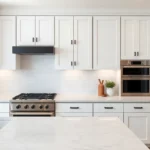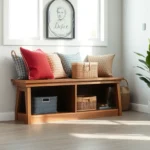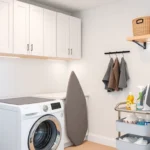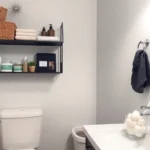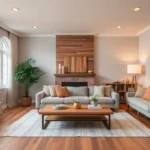Your home’s floors serve as the foundation for every design decision you’ll make. Whether you’re building from scratch or refreshing an existing space, choosing the right flooring sets the tone for your entire home’s aesthetic and functionality.
We’ve all walked into a room and felt instantly impressed by stunning floors that perfectly complement the space. From luxurious hardwood patterns to innovative tile layouts and creative mixed-material designs, today’s flooring options offer endless possibilities to transform any room into something extraordinary.
The best part? You don’t need a massive budget or professional designer to achieve magazine-worthy results. With the right inspiration and practical knowledge, you can create floors that not only look incredible but also stand up to your family’s daily life. Let’s explore the most inspiring floor design ideas that’ll elevate your space and increase your home’s value.
Hardwood Floor Design Ideas That Never Go Out of Style
Hardwood floors remain the gold standard for sophisticated home design. These natural wood options create lasting beauty that adapts to changing decor trends while maintaining their inherent elegance.
Classic Oak Patterns for Timeless Appeal
Oak flooring delivers unmatched versatility with its distinctive grain patterns and natural durability. We recommend white oak for modern spaces because it accepts stains beautifully and creates a neutral backdrop for furniture and decor. Red oak brings warmth to traditional interiors with its prominent grain lines and rosy undertones.
Plank widths make a important impact on visual perception. Wide planks measuring 5 to 7 inches create a contemporary look that makes rooms appear larger. Narrow planks between 2.25 to 3 inches offer classic charm that works particularly well in colonial and craftsman style homes.
Herringbone patterns using oak planks add sophisticated geometry to any space. This installation method creates visual interest while maintaining the timeless appeal of natural wood. Parquet designs with oak squares provide another classic option that brings formal elegance to dining rooms and entryways.
Exotic Wood Species for Luxury Finishes
Brazilian cherry stands out as one of the most sought after exotic hardwoods for flooring. Its rich reddish brown color deepens over time, creating stunning depth that transforms any interior. This species offers exceptional hardness ratings that ensure decades of beautiful performance.
Teak flooring brings spa like luxury to residential spaces with its natural water resistance and golden honey tones. We’ve seen teak floors maintain their beauty for over 50 years with proper maintenance. The wood’s natural oils provide built in protection against moisture and insects.
Mahogany creates dramatic focal points with its deep reddish brown color and straight grain patterns. This premium wood species works exceptionally well in libraries, studies, and formal living spaces. African mahogany offers similar beauty at a more accessible price point than its South American counterparts.
Walnut flooring provides rich chocolate brown tones that complement both modern and traditional design schemes. American black walnut features beautiful grain variations that make each plank unique. This domestic exotic species supports sustainable forestry while delivering luxury aesthetics.
Distressed and Reclaimed Wood Options
Reclaimed barn wood brings authentic character that new materials simply cannot replicate. These weathered planks tell stories through their nail holes, saw marks, and natural patina developed over decades of use. We source reclaimed wood from demolished barns, factories, and warehouses to create flooring with genuine historical significance.
Hand scraped finishes create texture and visual depth that hides everyday wear and tear. This technique involves skilled craftsmen using traditional tools to create subtle surface variations. The result is flooring that looks naturally aged and develops even more character over time.
Wire brushed hardwood removes soft grain fibers to highlight the natural wood texture. This process creates subtle ridges that feel pleasant underfoot while adding visual dimension. Wire brushed floors work particularly well in rustic and transitional design schemes.
Distressed oak planks combine the reliability of traditional oak with the character of aged wood. Modern distressing techniques create authentic looking knots, dings, and color variations. These floors offer the best of both worlds: new wood performance with vintage aesthetic appeal.
Tile Floor Design Ideas for Modern Living Spaces

We’ve explored hardwood’s timeless appeal, but tile flooring offers equally stunning possibilities for contemporary homes. Modern tile designs bring versatility and durability while creating sophisticated visual statements that complement today’s design trends.
Large Format Tiles for Seamless Looks
Large format tiles create the ultimate minimalist foundation for open plan interiors in 2025. These expansive surfaces reduce grout lines significantly, establishing continuous visual flow that makes spaces appear larger and more cohesive. We recommend choosing tiles with smooth finishes or subtle textures that align with sensorial minimalism trends, adding refined tactile elements without overwhelming the design.
Warm neutral tones work exceptionally well in contemporary settings, while tiles mimicking natural wood and stone bring organic warmth to modern spaces. The seamless appearance particularly benefits living rooms and kitchens where uninterrupted sight lines enhance the perception of space. Installing large format tiles requires precise measurement and professional technique, but the resulting clean aesthetic transforms ordinary rooms into sophisticated environments.
Mosaic Patterns for Visual Interest
Mosaic tiles introduce artistry and visual intrigue through small, patterned arrangements that create stunning focal points. Modern applications use these detailed surfaces as accent features or full floor installations to break up larger areas and highlight exact zones. Bold geometric patterns, intricate arrangements, and checkerboard layouts are trending choices for their ability to add personality while maintaining durability.
Kitchens benefit from mosaic backsplash transitions to floor patterns, while bathrooms showcase intricate designs that create spa like atmospheres. Entryways make powerful first impressions with carefully planned mosaic installations that welcome guests with artistic flair. We suggest using mosaics strategically rather than overwhelming entire spaces, allowing these detailed patterns to serve as conversation pieces that complement rather than compete with other design elements.
Natural Stone Tile Combinations
Combining different natural stone types creates luxurious, organic textures that bring sophistication to modern living spaces. Marble, limestone, and slate work beautifully together when used in various sizes, finishes, and colors to provide unique layered appearances. Honed or brushed stone tiles offer subtle texture that appeals to touch while diffusing light effectively, perfectly complementing contemporary sensorial minimalism trends.
We recommend pairing stone combinations with understated decor to ensure the flooring remains the standout element of your overall design scheme. These natural materials bring timeless beauty and durability that increases home value while creating environments that feel both luxurious and welcoming. Stone tile combinations work particularly well in bathrooms, foyers, and living areas where the organic textures create calming, spa like atmospheres that enhance daily living experiences.
Creative Carpet Floor Design Ideas for Comfort and Style

Carpets offer endless possibilities for creating inviting spaces that balance visual appeal with practical comfort. We’ll explore innovative approaches that transform floors into design statements while maintaining the cozy atmosphere carpets naturally provide.
Bold Geometric Patterns and Colors
Checkerboard patterns create striking visual impact by alternating two contrasting colors or textures throughout your space. Living rooms and dining areas benefit most from this classic approach, which adds structured elegance without overwhelming existing decor. We recommend using neutral tones like cream and charcoal for sophisticated environments, or bold combinations like navy and gold for dramatic effect.
Stripes and borders define room perimeters using contrasting colors that guide the eye around your space. Open-concept homes particularly benefit from this technique, as it creates natural boundaries between different functional areas. Horizontal stripes make rooms appear wider, while vertical applications add perceived height to compact spaces.
Random mix combinations bring vibrant energy to creative environments by blending various colors and patterns without strict organization. Playrooms and home offices thrive with this approach, as it encourages creativity while hiding minor stains or wear patterns. We suggest limiting your palette to three coordinating colors to maintain visual cohesion even though the random placement.
Textured Carpets for Added Dimension
Loop pile textures create subtle visual depth while maintaining easy maintenance in high-traffic areas. Berber and level loop styles work exceptionally well in family rooms and hallways, offering durability without sacrificing aesthetic appeal. These textures naturally hide footprints and vacuum marks, making them ideal for busy households.
Cut and loop combinations provide sophisticated contrast by combining different pile heights within single carpet installations. This technique works beautifully in formal living spaces where you want textural interest without bold color statements. Geometric patterns emerge naturally from the height variations, creating subtle visual movement across your floors.
Plush pile carpets deliver ultimate comfort underfoot while adding luxurious visual weight to bedrooms and private retreats. We recommend reserving these softer textures for lower-traffic areas where their beauty can be preserved longer. The light-catching properties of plush fibers create natural highlighting that enhances room brightness.
Area Rug Layering Techniques
Layering over carpet transforms existing flooring by placing smaller, vibrant rugs strategically over larger neutral carpeted areas. This approach creates instant focal points while protecting high-wear zones beneath furniture groupings. We suggest choosing rugs that contrast with your base carpet in either color, pattern, or texture for maximum visual impact.
Layering on hard flooring defines distinct zones within rooms while adding warmth and sound absorption to tile or hardwood surfaces. Multiple smaller rugs work better than single large pieces for creating flexible arrangements that can adapt to changing furniture layouts. This technique proves especially valuable in studio apartments or loft spaces where visual separation enhances functionality.
Size coordination strategies ensure your layered rugs complement rather than compete with each other by following proportional guidelines. The bottom layer should extend at least 18 inches beyond the top rug on all sides, creating proper visual framing. We recommend keeping patterns to the top layer while using solid or subtle textures underneath for balanced compositions.
Luxury Vinyl Floor Design Ideas on a Budget
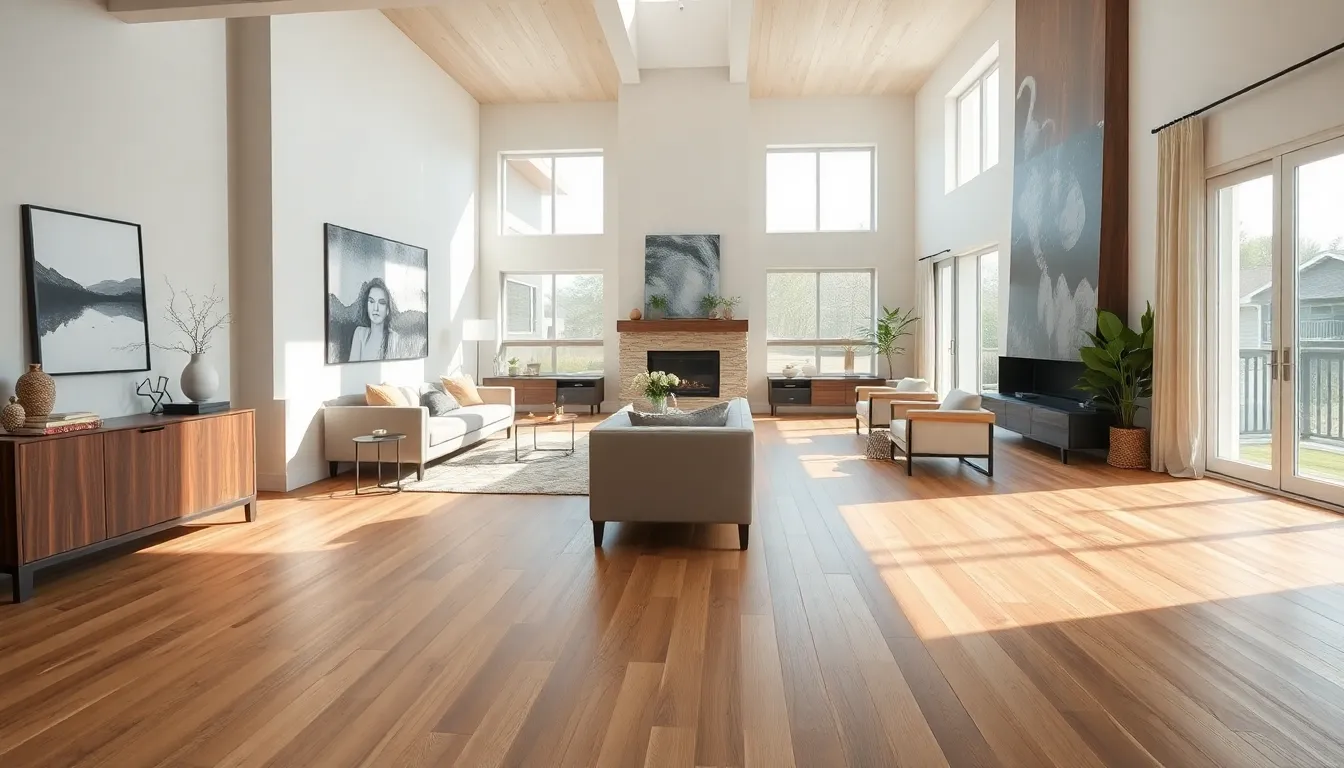
Luxury vinyl flooring delivers premium aesthetics without the premium price tag. We can achieve stunning floor designs that rival expensive materials while staying within budget constraints.
Wood-Look Planks That Mimic Real Hardwood
Wood grain patterns in luxury vinyl planks offer authentic hardwood appearance at a fraction of the cost. Premium LVP options feature realistic textures and color variations that closely replicate oak, cherry, and walnut species.
Affordability makes LVP an ideal choice for homeowners seeking wood aesthetics without hardwood’s maintenance requirements. Installation costs remain lower since luxury vinyl planks often feature click-lock systems that simplify the process.
Durability surpasses traditional hardwood in moisture-prone areas like kitchens and bathrooms. Water resistance and scratch protection make these planks perfect for active households with pets and children.
Tile-Look Options for High-Traffic Areas
Luxury vinyl tiles excel in high-traffic spaces where durability matters most. These LVT options withstand heavy foot traffic while maintaining their appearance over years of use.
Design versatility allows us to achieve ceramic, porcelain, or natural stone looks without the cold surface or grout maintenance. Popular patterns include subway, hexagon, and large format designs that create modern appeal.
Water resistance makes luxury vinyl tiles ideal for entryways, mudrooms, and laundry areas. Installation over existing floors often eliminates costly demolition and reduces project timelines.
Creative Installation Patterns
Herringbone patterns create sophisticated visual interest that elevates any room’s design appeal. This classic arrangement works beautifully with wood-look planks to achieve timeless elegance on a budget.
Chevron layouts offer modern alternatives to traditional straight installations. Angular designs add ever-changing movement and can make small spaces appear larger through strategic visual flow.
Grid arrangements with contrasting colors or textures create striking geometric effects. Mixed width planks or alternating tile sizes produce custom looks that appear professionally designed without designer costs.
Mixed Material Floor Design Ideas for Unique Spaces

Mixing different flooring materials creates stunning visual impacts while defining functional zones throughout your home. Strategic combinations transform ordinary spaces into designer showcases that reflect your personal style.
Combining Wood and Tile Transitions
Curved transitions between tile and wood create smooth, cohesive flows that eliminate harsh lines between different materials. We recommend using curved metal strips or custom-cut transition pieces to blend herringbone wood patterns with geometric tile designs seamlessly.
Contrasting patterns add dramatic visual interest when you pair wood flooring with complementary tile arrangements. Bold geometric tile patterns create striking focal points against traditional wood planks, while maintaining functional benefits in moisture-prone areas like kitchen entries or mudrooms.
Professional installation techniques ensure durability at transition points where different materials meet. We suggest using moisture barriers and proper subflooring preparation to prevent warping or separation over time.
Stone and Concrete Industrial Looks
Exposed concrete paired with natural stone accents delivers industrial-chic aesthetics perfect for modern loft conversions and urban living spaces. Raw concrete provides cost-effective coverage for large areas while stone elements add luxurious texture and visual warmth.
Stone accent strips within concrete floors create sophisticated patterns that break up expansive surfaces without overwhelming smaller rooms. We’ve seen stunning results using slate, granite, or travertine inserts to define pathways or create geometric designs within polished concrete foundations.
Industrial materials offer exceptional durability for high-traffic commercial spaces or busy family areas. Maintenance requirements stay minimal while design impact remains maximum, making these combinations ideal for contemporary homes seeking low-maintenance luxury.
Carpet and Hardwood Zoning Techniques
Zone definition using carpet creates cozy reading nooks and intimate conversation areas while hardwood maintains continuous flow throughout larger spaces. We recommend using area rugs or carpet tiles to establish boundaries without permanent installation commitments.
Texture contrast between plush carpet and smooth hardwood adds depth and visual interest to open floor plans. Strategic placement of soft carpet areas provides comfort in seating zones while hardwood ensures easy maintenance in dining and kitchen areas.
Carpet islands within hardwood floors offer flexible design answers that adapt to changing furniture arrangements and lifestyle needs. This approach allows you to update color schemes and textures without major renovation investments while maintaining the timeless appeal of quality hardwood flooring.
Small Space Floor Design Ideas That Maximize Visual Impact
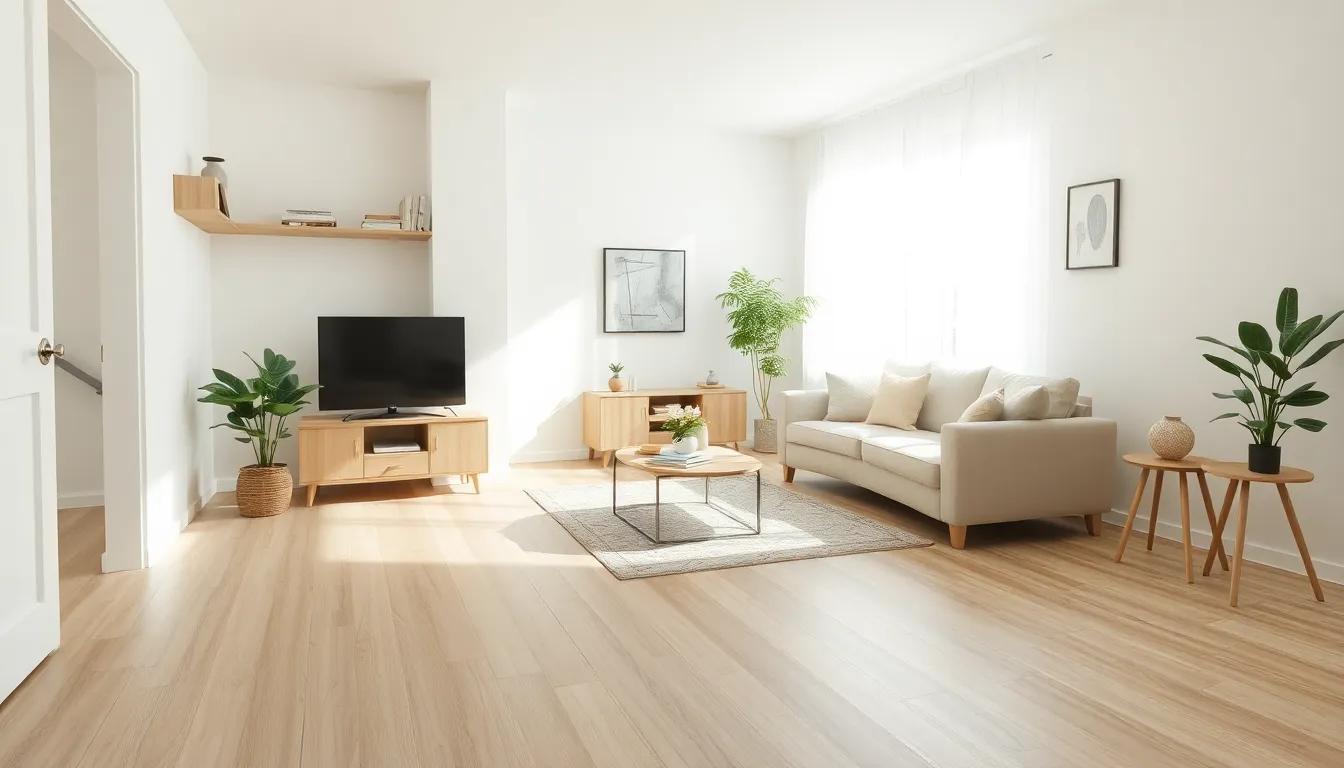
Small spaces present unique design challenges that require strategic flooring choices to create the illusion of size and openness. We’ve identified key techniques that transform compact areas into visually expansive environments.
Light Colors to Open Up Rooms
Light colored flooring instantly makes small rooms appear larger by reflecting more natural light throughout the space. Luxury vinyl plank (LVP) flooring in lighter shades creates a brighter, more spacious atmosphere while maintaining durability and style. Warm whites and soft beiges work particularly well for creating this expansive effect. Pale oak tones and bleached wood looks provide natural warmth without overwhelming compact spaces. We recommend selecting flooring that’s at least two shades lighter than your wall color to maximize the room opening effect.
Diagonal Installation Patterns
Diagonal patterns visually expand rooms by creating movement and dynamism that draws the eye across the entire space. Installing tiles or planks at a 45 degree angle to the walls makes narrow rooms appear wider and short rooms feel longer. This installation technique works exceptionally well with both ceramic tiles and luxury vinyl planks. Herringbone and chevron patterns laid diagonally create sophisticated visual interest while making spaces feel more expansive. Vertical crosshatch patterns involving perpendicular tile stacks help elongate spaces by creating an upward sense of motion.
Continuous Flooring Throughout Connected Spaces
Installing identical flooring throughout connected areas creates visual continuity that makes spaces feel larger and more cohesive. Open floor plans benefit significantly from this approach as it eliminates visual barriers between rooms. We suggest carrying the same flooring from entryways through living areas and into kitchens for maximum impact. This technique works particularly well when combined with nesting and minimal furniture placement to maintain openness and flow. Consistent flooring materials eliminate visual breaks that can make spaces feel choppy and smaller than they actually are.
Eco-Friendly Floor Design Ideas for Sustainable Homes
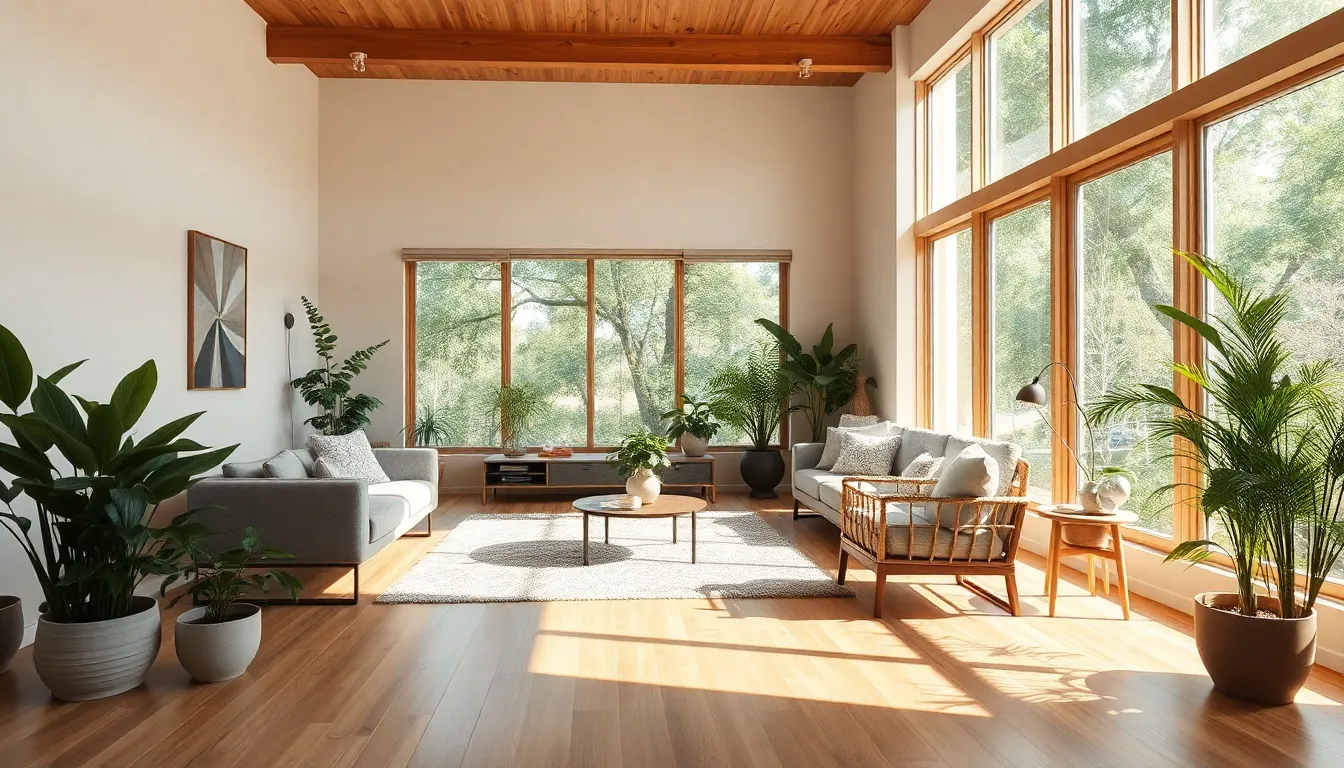
Sustainable flooring choices offer homeowners the opportunity to reduce environmental impact while creating beautiful living spaces. We’ve identified the most effective eco-friendly materials that combine environmental responsibility with exceptional design potential.
Bamboo Flooring Installation Options
Bamboo flooring delivers exceptional durability with a regrowth rate that makes it one of the most renewable flooring materials available. We recommend considering two primary installation methods based on your exact bamboo type and existing floor conditions.
Nail-down installation works perfectly for solid bamboo planks, requiring subflooring attachment for maximum stability. This method provides the strongest foundation for high-traffic areas and ensures decades of reliable performance.
Floating floor installation offers versatility for engineered bamboo products, allowing installation over existing flooring without removal. This approach reduces installation costs and timeframes while maintaining the authentic bamboo aesthetic that homeowners desire.
Cork Flooring for Natural Insulation
Cork flooring provides natural thermal and sound insulation properties that create comfortable living environments year-round. We’ve found that cork’s unique cellular structure offers temperature regulation benefits that help maintain stable room conditions.
Temperature regulation occurs naturally through cork’s insulating properties, reducing heating and cooling costs while maintaining consistent comfort levels. This renewable resource comes from cork oak tree bark, making it completely sustainable without harming the tree.
Durability benefits include a soft, cushioned surface that reduces foot fatigue and provides joint comfort during daily activities. Cork’s natural antimicrobial properties resist mold and bacteria growth, creating healthier indoor air quality for families.
Recycled Material Flooring Answers
Recycled flooring materials transform waste products into stunning design elements that reduce environmental impact significantly. We’ve identified three exceptional options that combine sustainability with remarkable aesthetic appeal.
| Material Type | Source | Key Benefits |
|---|---|---|
| Reclaimed Wood | Old buildings, salvaged trees | Unique character, reduced waste |
| Recycled Glass Tiles | Crushed consumer glass | Durability, water resistance |
| Recycled Plastic Flooring | Post-consumer plastic waste | Moisture resistance, easy maintenance |
Reclaimed wood offers unmatched character with unique weathering patterns and historical significance from salvaged buildings. Each plank tells a story while preventing quality lumber from entering landfills.
Recycled glass tiles provide exceptional durability through crushed glass composition, creating water-resistant surfaces perfect for kitchens and bathrooms. These tiles offer unlimited color and pattern possibilities while diverting waste from disposal sites.
Recycled plastic flooring transforms post-consumer plastic waste into water-resistant surfaces ideal for basements and outdoor spaces. This innovative material requires minimal maintenance while providing long-lasting performance in challenging environments.
Additional sustainable options include earth floors made from locally sourced soil, clay, and sand materials that create unique, region-exact aesthetics. Engineered hardwood flooring reduces wood waste during production while providing the classic hardwood appearance homeowners love. Terrazzo flooring incorporates recycled glass, stone, and concrete fragments into durable surfaces that offer endless design customization possibilities.
Bold Statement Floor Design Ideas for Dramatic Interiors
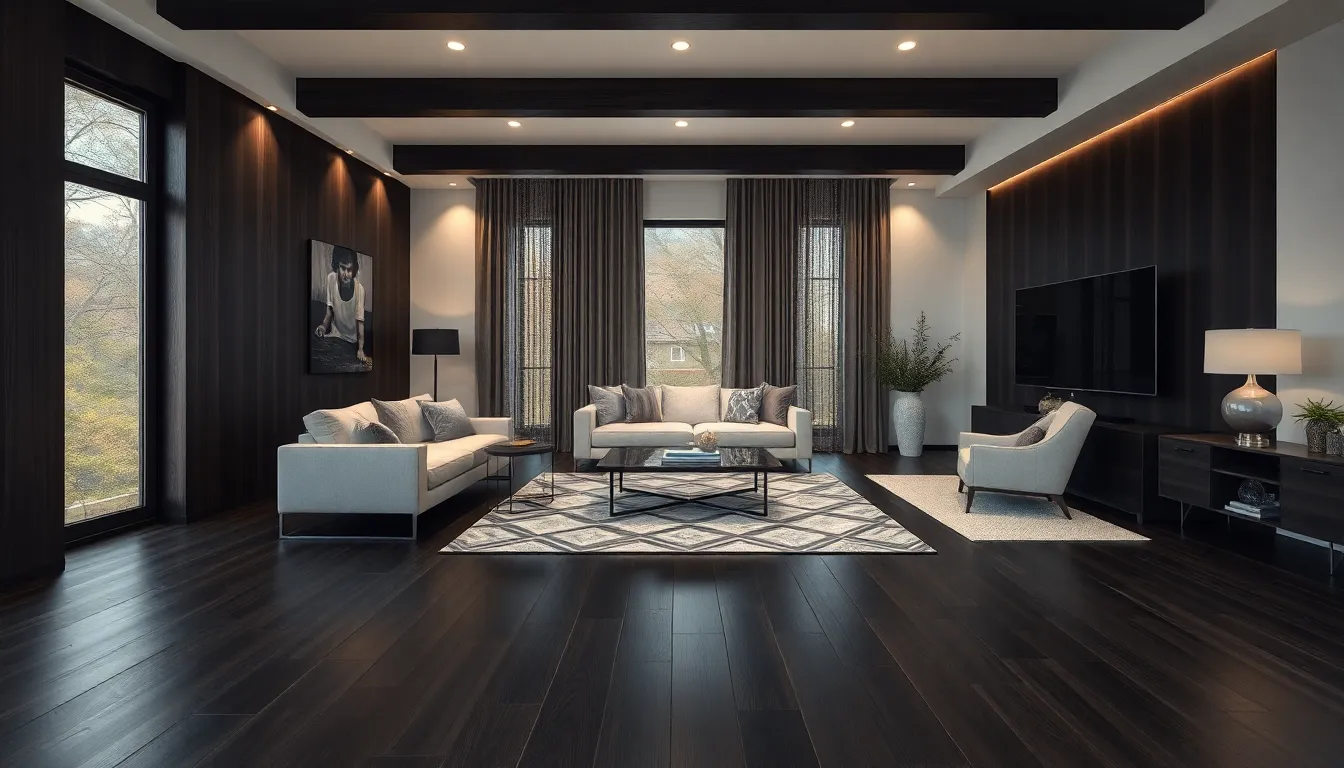
We’ve explored sustainable and small space answers, but now we’re diving into flooring designs that command attention and transform rooms into show-stopping spaces. Bold statement floors serve as the foundation for dramatic interiors that leave lasting impressions.
Dark Dramatic Flooring Choices
Dark wood floors create sophisticated drama that elevates any interior space. We recommend pairing these rich, deep tones with lighter wall colors and furniture to establish striking visual contrast. Dark porcelain tiles offer a sleek modern alternative that works exceptionally well in contemporary settings.
Ebony and walnut hardwood species deliver the most dramatic impact among natural wood options. Installing these darker woods in wide plank formats enhances their bold presence throughout the room. Dark-colored porcelain tiles provide similar visual weight while offering superior durability in high-moisture areas like bathrooms and kitchens.
Charcoal and black tile installations create stunning backdrops for minimalist furniture and bright accent pieces. We’ve seen homeowners achieve remarkable results by combining dark floors with strategic lighting to prevent spaces from feeling too enclosed.
Colorful Painted Floor Techniques
Painted hardwood floors bring vibrant personality to vintage and eclectic design schemes. We suggest using high-quality floor paint specifically designed for foot traffic to ensure longevity. Bold colors like navy blue, forest green, or deep burgundy work particularly well in dining rooms and home offices.
Epoxy floor coatings transform concrete surfaces into colorful masterpieces with exceptional durability. These coatings resist stains and scratches while offering unlimited color possibilities for basements, garages, and modern loft spaces. Metallic epoxy finishes create particularly stunning effects that shift and shimmer under different lighting conditions.
Stenciled patterns over painted base colors add another layer of visual interest without overwhelming smaller spaces. We recommend testing color combinations on sample boards before committing to full room applications.
Unique Pattern and Border Designs
Geometric tile patterns like hexagons and chevrons inject vibrant personality into any room design. We’ve observed how these patterns work especially well in entryways and powder rooms where they create immediate visual impact. Herringbone installations using contrasting tile colors amplify the geometric effect.
Mosaic tile arrangements form beautiful custom patterns that add personal touches to flooring designs. These intricate installations work exceptionally well as border treatments around room perimeters or as central medallions in formal dining areas. Wood inlay patterns create similar effects with sophisticated elegance.
Statement carpets with bold geometric or floral patterns dramatically change room ambiance while providing warmth and comfort. We suggest using these vibrant pieces in living areas where softer flooring feels more appropriate than hard surfaces. Contrasting border treatments frame rooms beautifully and define separate functional zones within open floor plans.
Conclusion
We’ve explored an incredible range of flooring possibilities that can transform any space from ordinary to extraordinary. Whether you’re drawn to the timeless elegance of hardwood or the practical beauty of luxury vinyl each option offers unique opportunities to express your style while meeting your functional needs.
The key to successful floor design lies in understanding how different materials work within your exact space and lifestyle. From eco-friendly bamboo that supports sustainable living to bold statement floors that create dramatic focal points we’ve shown you that beautiful flooring is achievable regardless of your budget or room size.
Remember that your floors set the foundation for everything else in your home. Choose wisely and you’ll create spaces that not only look stunning but also add lasting value to your property while reflecting your personal aesthetic vision.
Frequently Asked Questions
What makes hardwood flooring a good choice for home design?
Hardwood flooring remains the gold standard for sophisticated home design due to its lasting beauty and adaptability to changing decor trends. It offers timeless appeal, increases home value, and works well with both modern and traditional interior styles. Options like white oak for contemporary spaces and red oak for classic interiors provide versatility for any design vision.
How do large format tiles benefit modern home design?
Large format tiles create a minimalist foundation by reducing grout lines and enhancing visual flow, especially in open-plan interiors. They offer a clean, contemporary look while being durable and low-maintenance. These tiles work particularly well in warm neutral tones and can mimic natural materials for a cohesive, sophisticated appearance.
Can carpet flooring work in modern interior design?
Yes, carpet flooring can create inviting modern spaces when chosen thoughtfully. Bold geometric patterns like checkerboard and stripes add structured elegance, while textured carpets offer durability and visual interest. Area rug layering techniques can define zones and create focal points, balancing comfort with contemporary aesthetics.
Is luxury vinyl flooring a good alternative to real hardwood?
Luxury vinyl flooring offers premium aesthetics at a budget-friendly price point. Wood-look planks provide authentic hardwood appearance with lower maintenance and installation costs. It’s highly durable, suitable for moisture-prone areas, and offers design versatility with creative installation patterns like herringbone and chevron.
How can mixed materials enhance floor design?
Combining different flooring materials creates stunning visual impact and defines functional zones within spaces. Seamless blending of wood and tile through curved transitions, pairing concrete with natural stone accents, or using carpet and hardwood zoning techniques can create sophisticated, multi-dimensional interiors while maintaining cohesive flow.
What flooring options work best for small spaces?
Light-colored flooring reflects natural light and creates a sense of openness in compact areas. Diagonal installation patterns enhance the perception of space, while maintaining consistent flooring throughout connected areas fosters visual continuity. These techniques help transform small spaces into visually expansive, welcoming environments.
Are there eco-friendly flooring options available?
Yes, sustainable flooring includes bamboo (durable and renewable), cork (natural insulation properties), and recycled materials like reclaimed wood and recycled glass tiles. These options reduce environmental impact while offering exceptional design potential, healthier indoor air quality, and unique aesthetic appeal for environmentally conscious homeowners.
How can I create bold statement floors?
Dark wood and porcelain tiles add sophistication and visual contrast when paired with lighter wall colors. Colorful painted floor techniques using high-quality floor paint or epoxy coatings add vibrancy. Unique patterns like geometric tiles and mosaic arrangements inject personality and create dramatic focal points in any room.


